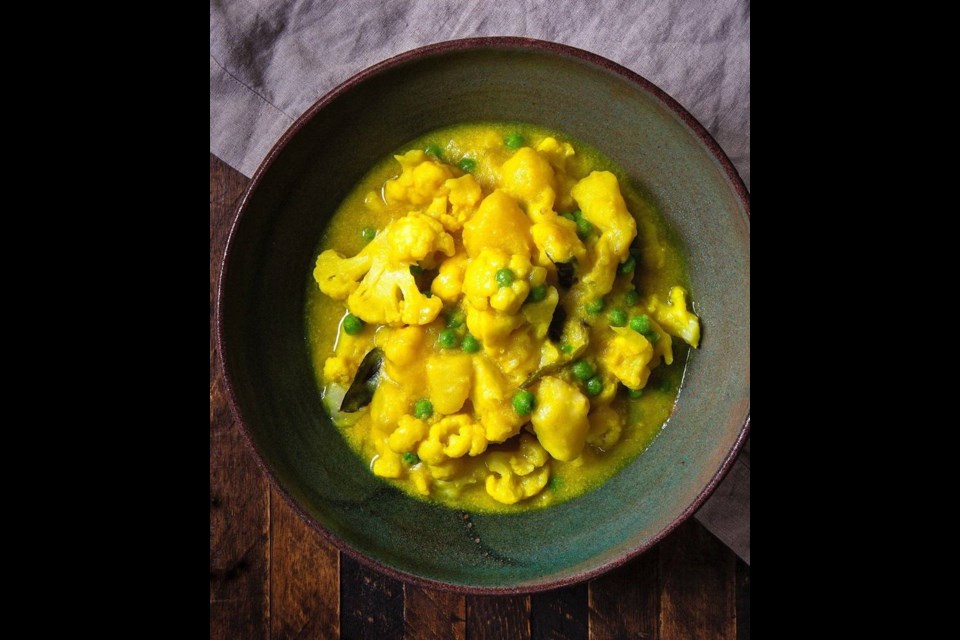Taking a long flight somewhere to enjoy new cultures and foods is not, for obvious reasons, in most of our current plans. We’re staying close to home and looking forward to the day that we can travel like that again.
But that doesn’t mean we can’t get a big bite of what that journey might be like. That’s how I felt when reading Ruwanmali Samarakoon-Amunugama’s recently published book Milk, Spice & Curry Leaves: Hill Country Recipes from the Heart of Sri Lanka (TouchWood Editions, $35.)
Samarakoon-Amunugama, who was born in Mississauga and attended Simon Fraser University, says the book was inspired by her parents, grandparents and numerous trips to Sri Lanka over many years that informed and defined his experience of Sri Lankan hill country comfort foods.
Because of its shape and location, some call the lush, tropical South Asian island nation “the pearl of the Indian ocean.” Samarakoon-Amunugama’s culinary exploration begins with describing her family’s travels in that country, in particular the road from the coastal city of Colombo, Sri Lanka’s capital, to Peradeniya, part of the city of Kandy, located in the central highlands of the country (a.k.a. hill country). It’s a car ride that took Samarakoon-Amunugama on winding roads, past tea estates and farm stalls selling jackfruits, mangoes and papayas.
“As a child sitting in the back seat, I would watch the remarkable transition from bustling Colombo city life with its open shops and street vendors to slow-paced village life in Peradeniya,” writes Samarakoon-Amunugama.
In Peradeniya, she stayed at her grandmother’s house, where she remembers awakening each morning to birdsong, visits from family and friends, and happy, informal reunions with them around delicious meals.
In a section called The Essence of Sri Lankan Cooking, she notes that there is an art to the cuisine her grandmother was preparing: the intentional blending of plants and spices and a careful balancing of fats, acids, starches, proteins and grains.
That sounds complicated, but Samarakoon-Amunugama writes that Sri Lankans tend to refer to their way of eating as the “rice and curry” diet — not too onerous to prepare, even when dishes are layered with a world of flavour.
She says that in Canada, her mother carried on family traditions learned in Sri Lanka, including cooking foods enjoyed there, often with Samarakoon-Amunugama by her side.
“ I spent many years next to my mother in the kitchen as her sous chef, simply observing her use of ingredients and spices,” Samarakoon-Amunugama says. “It encouraged me to learn the ingredients, plants and spices — through sight, touch and taste — that might have otherwise been intimidating.”
Samarakoon-Amunugama shares that wealth of knowledge in her book, which offers nine chapters of inspired recipes, including those for grains, vegetables, salads, fruit, nut and lentils, seafood, meat and poultry, and small bites to enjoy with tea. Some of the recipes include winter squash curry, coconut roti, devilled prawns, pineapple salad, mango curry and pepper beef with coconut milk and mustard seed.
Sri Lankan meals are often multi-dish affairs and throughout the book Samarakoon-Amunugama offers suggestions on what recipes can be served together. The book also has a chapter called “The Pillars” that offers an A to Z guide on essential flavourings.
When creating her book, Samarakoon-Amunugama said she wanted a depth of visuals — illustrations and colour and also vintage black and white photography — for readers to plunge into.
“I wanted to express that food is (or should be) more than what we simply consume at regular intervals of the day,” Samarakoon-Amunugama said. “We often associate our favourite recipes and comfort foods with memories of a time, place or person — I wanted to touch on the nostalgic qualities of food.”
Cauliflower, Potatoes, and Green Peas Curry
This recipe is from Ruwanmali Samarakoon-Amunugama’s recently published Milk, Spice & Curry Leaves: Hill Country Recipes from the Heart of Sri Lanka (TouchWood Editions, $35.00.) Serves four to six when accompanied with other dishes.
1 lb (about half a head) white cauliflower, cored
1/2 lb white or red potatoes
1/2 cup red onion, finely chopped
1 small whole green (Thai) chili
4–6 curry leaves, ripped into small pieces (see Note 1)
1-inch-long piece of pandanus leaf, fresh or frozen (see Note 2)
• heaping 1/2 tsp ground turmeric
1/4 tsp fenugreek seeds
1 tsp fine sea salt, or to taste
¾ to 1 cup coconut milk (see Note 2)
1/4 cup frozen peas
1 small lime wedge (yielding about 1 tsp juice)
Cut the cauliflower into bite-sized pieces and set aside. Peel the potatoes, cut them into 1 1/2-inch cubes.
In a large pot over medium-high heat, place the potatoes, onion, chili, curry leaves, pandanus leaf, turmeric, fenugreek, salt, and 3/4 cup of the coconut milk. Let cook, covered, until the potatoes are parboiled, 5 to 7 minutes.
Add the cauliflower, turn down the heat to medium-low, and cover again. Let simmer, stirring occasionally, until the cauliflower is tender, approximately 15 minutes.
Add the remaining 1/4 cup of coconut milk, if needed, and/or 1/4 cup water, if you wish to thin the gravy slightly. Add salt to taste, and add the peas, and let cook, uncovered, for 2 minutes.
Squeeze the lime over the curry, stir to combine flavours, and remove the pot from the heat. Let sit, partially covered, for 10 to 15 minutes to blend the flavours. Remove the pandanus leaf before serving.
Note 1: Fresh curry leaves are sold at Asian-style markets and some grocery stores. I found them at Fairway Market.
Note 2: Pandanus leaf is sold at some Asian-style markets. If you can’t find it, Ruwanmali Samarakoon-Amunugama says to simply make the recipe without it.
Eric Akis is the author of eight cookbooks. His columns appear in the Life section Wednesday and Sunday.



